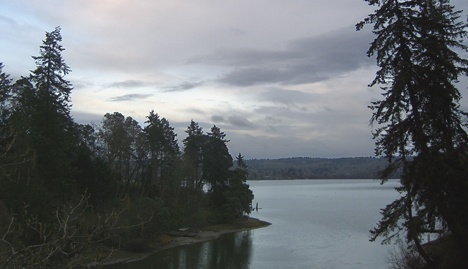King County, the state Department of Ecology and the University of Washington are about to begin a four-year project to determine the impact high nitrogen levels are having on Quartermaster Harbor, a bay some believe is in ecological trouble.
The study, funded in part by a $625,000 grant from the U.S. Environmental Protection Ag-
ency, will enable scientists to determine more precisely whether nitrogen-loading is leading to the bay’s depleted oxygen levels — levels so low they could be lethal for some fish species and other marine organisms. The study will also help scientists determine the sources of the nitrogen, said Curtis DeGasperi, a hydrologist at the county’s Department of Natural Resources and Parks and the lead on the Quartermaster Harbor Nitrogen Management Study.
Over the past couple of years, water samples taken from the harbor show very low levels of dissolved oxygen, a potentially serious situation, DeGasperi said. Low oxygen levels have been implicated in the massive fish kills that have plagued Hood Canal and other water bodies in recent years. But scientists don’t yet know if those low levels of oxygen and high levels of nitrogen reflect the bay’s natural conditions or if failing septic systems, livestock manure or other sources are the culprit, he said.
The research project, he said, provides “an opportunity to apply a lot of expertise developed over a long period of time … to really try to identify the various influencing factors and identify some that we can actually control so as to hopefully improve the situation in Quartermaster Harbor.”
Skip Albertson, an oceanographer with the Department of Ecology, said the study will likely enable scientists to detect patterns in the way nitrogen levels ebb and flow in the bay and develop models that will enable them to make forecasts about the bay’s future health.
“The whole purpose of the study is to get very quantitative about the nitrogen sources and how they change through the course of a year,” he said.
Excess nitrogen, much of it thought to come from failing or inadequate septic systems, has been identified as a major source of pollution in parts of Puget Sound.
The naturally occurring element creates a cycle that can suffocate a water body: It triggers the rapid growth of algae, which eventually decomposes; as it does so, bacteria that break down the algae suck oxygen out of the water.
But recent studies in Hood Canal, where a series of fish kills over the last several years have alarmed scientists and conservationists, show that much of the nitrogen comes not only from failing septic systems. Natural oceanic cycles as well as alder trees — which take nitrogen out of the atmosphere and release it into the ground — are also sources.
DeGasperi and Albertson said their study of Quartermaster Harbor may provide similar insights.
The “gut feeling,” DeGasperi said, is that septic systems are the cause. “But at least in Hood Canal, it’s certainly not obvious that septics are the main source of the problem.”
Quartermaster has some natural conditions that may add to its low oxygen levels, they add. The bay was once open at Portage but is now completely closed, and thus it’s rarely flushed; it’s also a shallow bay, which makes it warmer and more prone to algae blooms.
What’s more, studies by a University of Washington Tacoma team have found that Quartermaster has a high level of an algae called Alexandrium catenella, which is known to cause “red tide” or paralytic shellfish poisoning.
Albertson said he and the other researchers hope to determine if there’s a connection between Quartermaster’s abundance of Alexandrium and its low oxygen levels.
“Both issues are affecting the health of the bay,” he said.
Susie Kalhorn, an Islander and environmental educator who has studied nitrogen’s role in the Island’s ecology, said she’s pleased this research project is about to occur.
The scientists plan to take what she called a holistic approach, examining not only the shorefront sources of nitrogen but the inland sources as well.
Such an approach is needed, she said, since shoreline homeowners are often blamed for all of the problems plaguing Quartermaster, when the issue may in fact be more complex.
“Thus far, there’s been a real focus only on shorefront homeowners and failing septic systems. But the concept that we all live in a watershed is really important,” she said. “Those of us who live inland have a responsibility as well.”
The project, she added, will also enable policy makers to determine responses that might be effective — responses that may be more creative and far-reaching than some realize. Restoring forests by planting more conifers could help, for instance, since conifers take up nitrogen from the soil, she said.
“Science informs decision-making, and it ought to inform decision-making,” she said.



